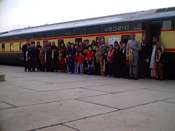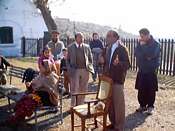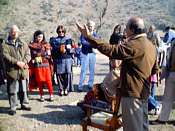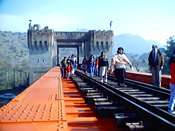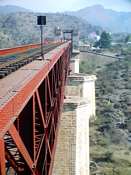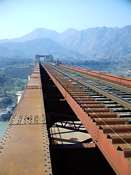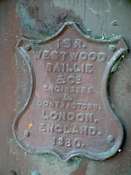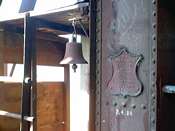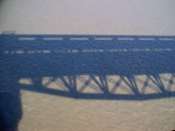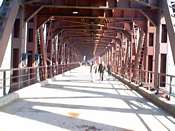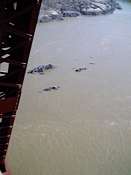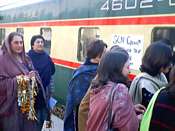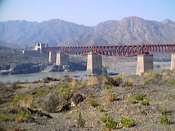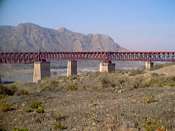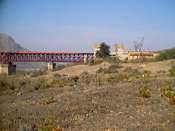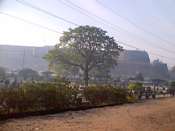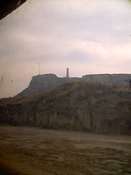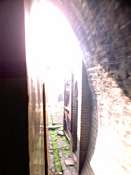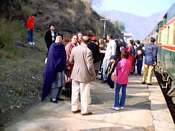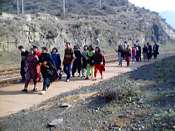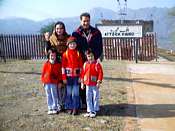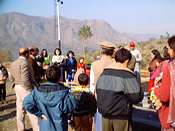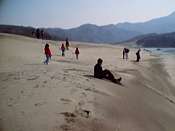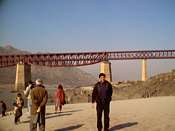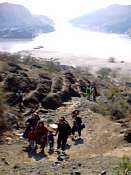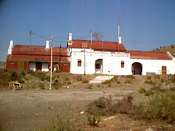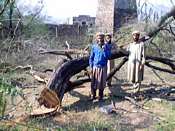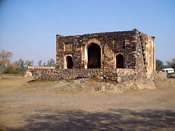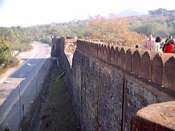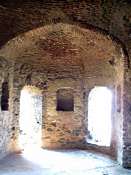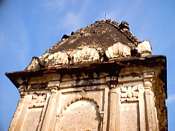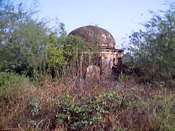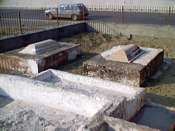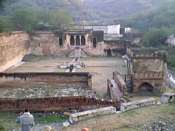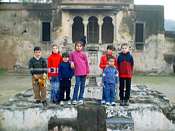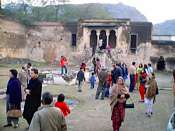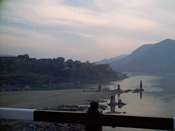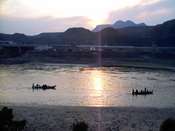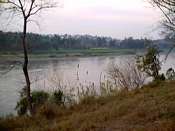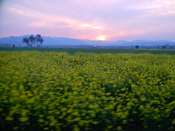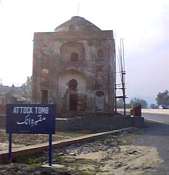| Copyright � 2004 [Sarhad Conservation Network]� All rights reserved. |
| Fun and Frolic at Attock |
| Keywords: indian khyber steam railways rail train safari nwfp north west frontier province of india pakistan bridge steel iron engineering british colonial heritage bridges attock city photos and pictures click here, click on photos to view in larger size |
| Sarhad Conservation Network (a local NGO concerned with heritage) and Sehrai Travel and Tours (pvt) Ltd jointly arranged an exciting journey to Attock by train recently. |
| Attock Old Bridge - Built 1880 |
| The train left the Peshawar Cantt station for it's onward journey to Attock Khurd on the morning of Sunday, 25th January 2004, carrying with it representatives of various tourism and heritage organizations. Besides SCN members, guests on board included scores of history enthusiasts and foreign and domestic tourists. |
| Attock has a rich history. The great mathematician and grammarian, Panini was born here in 520 BC. Akbar the Great built the fort in 1581, which has witnessed countless battles and skirmishes between the Sikhs and the Afghans. The Sikhs over-ran Attock in 1819 and within a few years the British had taken its possession and built the bridge of boats across Indus. It is said that the boat bridge was deliberately disrupted during the sepoy mutiny of 1857 and thus Frontier mutineers were prevented from playing any role in the Delhi rebellion. The renowned builders Joseph Westwood and Robert Baillie of the Westwood Baillie & Co, London, built the iron girder bridge in 1880. Apart from having a railway line above, it also has a way for wheeled traffic and foot passengers underneath. Ever since the use of the old route was discontinued for road traffic in the late 70s, the bridge has been lying abandoned. Yet it preserves its beauty and is a living testimony to the marvel of engineering of those times and is one of its kind in the world. |
| The visitors disembarked from the train at Attock Khurd. 'Khurd' is a Persian word for small. They were shown around the platform and were offered refreshments in the backdrop of the elegant colonial-styled building of the station, which has been preserved in its original state since more than a century. |
| After a week of relentless rains, the visitors were welcomed by a crisp and bright sunny day. They enjoyed the scenery and trekked to the old Attock Bridge under a cool refreshing breeze and enjoyed the beautiful view of the Kabul (Landai) and Indus rivers converging. |
| The area is famous for duck hunting in the rivers and for shooting black partridges on special game permits in the surrounding mountains. There is an abandoned English fishing hut and a rail track on the side where the British sometimes parked their famed vice-regal coupe` for a brief retreat and recreation. The river abounds in 'rao' 'mahasher' and other delicious varieties of fish. |
| The children played on white sands along the river while others enjoyed the beautiful scenery of the mountains. One could easily drift into nostalgia and imagine the haunting scene of the bygone days when the hordes of Alexander of Macedon traveled along this rugged mountain range, followed by various invaders of the subcontinent, and finally, where the Durrani and Sikh soldiers battled. The drumbeats signaled the charge of sword wielding horsemen. The chants from the charging lashkars, the sound of the horse hoofs and the clash of armour on both sides must have made a deafening noise. |
| One of the visitors, Dr Gulalai Wali Khan narrated the history of Attock during Mughal times. She gave a discourse on how religion was exploited by Akbar and Byazid Ansari and his decedents in the region in order to subdue the local tribes. She confessed that this was her first visit to all these places around Attock Khurd ever since the use of the old route was discontinued many years ago. |
| After a sumptuous lunch, the visitors were shown the structures of archeological importance: Attock fort, Begum ki Serai, Bahram ki Baradari, tomb of the unknown dancer and many Hindu, Jain and Sikh temples of the bygone era. Unfortunately the utter state of dilapidation and the pathetic standard of �restoration� of these precious sites is a sad commentary on the federal archeology department and the UNESCO that regularly issues declarations and arranges seminars on heritage in Islamabad. |
| Inside views of Begum Ki Serai - Attock |
| Hindu Religious Temple - Attock |
| These important archeological sites are not properly marked for visitors and unsightly encroachments have cropped up around them in recent years obscuring their heritage value and marring beauty. A group of woodchoppers were busy felling large trees inside the "protected" compound of Begum Ki Serai reportedly, "on the orders of the administration" at the nearby Attock Fort. |
| Tomb of the unknown Dancer - Grand Trunk Road Attock |
| Sunset & Mustard fields - Jehangira |
| The final stop was the Kund National Park where the visitors observed the wildlife and enjoyed the walk around the track. Zahoor Durrani of Sehrai Travels and Tours reminded that Pakistan's tourism industry was an important national asset and it had much potential to develop as an international tourist destination. But sadly there was lack of political will and effort on the part of the concerned authorities and the general public. He invited the public to visit the old bridge and enjoy picnics and barbeques there as his agency could arrange such camping tours. Dr Murad Ali said, Heritage preservation was a corner stone of SCN's guiding principles and he informed that the whole idea of arranging this visit was to introduce people to our rich heritage wealth. This was the first tour and hopefully, SCN would launch similar tours of other important sites like Golra Train Station by Steam Safari, Taxilla Museum and Takht Bhai Buddhist remains in the current year. SCN would also be focusing on Biodiversity in similar tours. |
| View of Attock Fort from Khairabad. The towers in the river were used to tie the Bridge of Boats in old times |
| It was a captivating journey indeed and the words of Khushal Khan Khattak came to mind who described the region as follows: (translated from Pushto) |
| "Every bounty that earth brings comes thither And when the rains fall, how lovely is the spring! What of Swat and Ashnaghar or Pekhawar or other lands, All bow down to it, and their bounty cometh thither." |
| Khushal Khan Khattak longed for his home during his imprisonment in Delhi by the Mughals and lamented in this manner: |
| "O gentle morning breeze, shouldst thou pass by Khairabad. Or should thy way lead thee by the side of Surai's stream, Whisper to them my greetings again, and yet again, Salute them that I love so dearly, To the Mighty Aba-Sind cry out with a loud voice, But whisper softly to the Landai stream! It may be perchance that I shall again drink from thee, Nor ever dwell beside the Ganga and the Jammna, In Hind are no cool waters for refreshment, God's curse upon it, though it be full of luxury; God grant that I may be one again with my beloved, Not forever will Khushal remain in Hind." |
| Kabul River - Near Kund, Khairabad |
| Views from the train window (L: Tunnel R: British Memorial At Nowshera) |
| Photos & Text by Ali Jan |
| Photos & Text by Ali Jan |
| View of Fort Balahisar - Peshawar from train |

